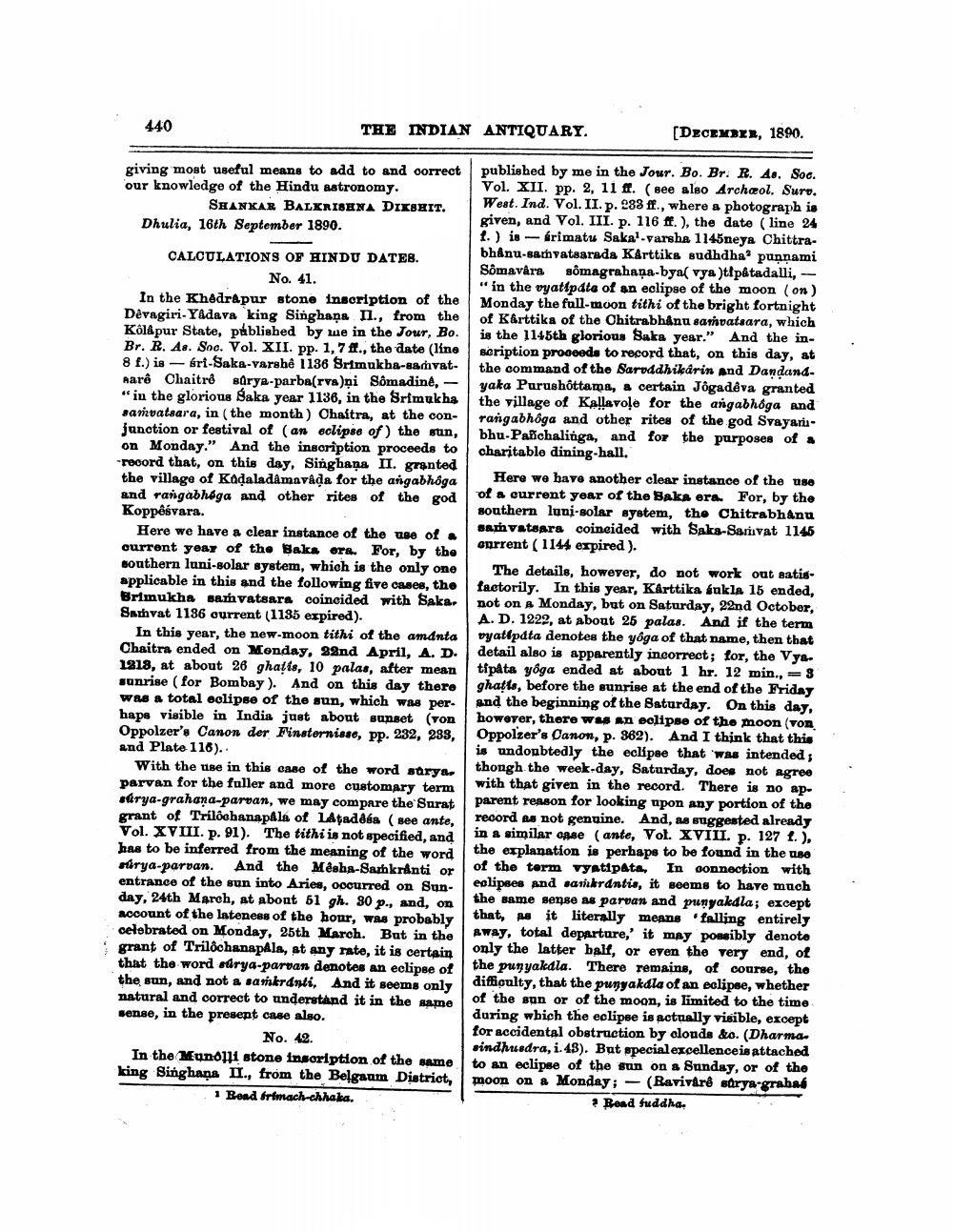________________
440
THE INDIAN ANTIQUARY.
[DECEMBER, 1890.
giving most useful means to add to and correct | published by me in the Jour. Bo. Br. R. As. Soc. our knowledge of the Hindu astronomy.
Vol. XII. pp. 2, 11 ff. (see also Archæol. Suro. SHANKAR BALKRISHNA DIKSHIT.
West. Ind. Vol. II. p. 288 ff., where a photograph is Dhulia, 16th September 1890.
given, and Vol. III. p. 116 ff.), the date (line 24
1. ) is - Srimatu Saka'-varsha 1145neya Chittra. CALCULATIONS OF HINDU DATES.
bhAnu-samvatsarada Kârttiks sudhdha punnami
Sömavara sômagrahaņa-byal vya )ttpâtadalli, - No. 41.
" in the vyatipdta of an eclipse of the moon (on) In the Khedrapur stone inscription of the Monday the full-moon tithi of the bright fortnight Dévagiri-Yadava king Singhaņa II., from the of Karttika of the Chitrabhånu samvatsara, which Kolapur State, published by we in the Jour, Bo. is the 1145th glorious Saka year." And the inBr. R. As. Soc. Vol. XII. pp. 1, 7ff., the date (line scription proceeds to record that, on this day, at 8 f.) is-sri-Saka-varsbê 1136 Srimukha-saóvat. the command of the Saroddhikarin and Dandandnarê Chaitro sdrya-parba(rva)ại Sômadine, -
yaka Purushottama, a certain Jôgadêva granted "in the glorious Saka year 1136, in the Srimukha the village of Kallavole for the angabhoga and samvatsara, in the month ) Chaitra, at the con- rangabhoga and other rites of the god Svayariajunction or festival of (an eclipse of the sun, bhu-Pafchalinga, and for the purposes of a on Monday." And the insoription proceeds to charitable dining-hall. record that, on this day, Singhaņa II. granted the village of Kadaladâmavada for the angabhôga
Here we have another clear instance of the use and rangabhoga and other rites of the god
of a current year of the Baka era. For, by the Koppeśvara.
southern luni-solar system, the Chitrabhanu Here we have a clear instance of the use of .
samvatsara coincided with Saka-Sarivat 1145 ourrent year of the Saks ors. For, by the
current ( 1144 expired ). southern luni-solar system, which is the only one The details, however, do not work out satisapplicable in this and the following five cases, the factorily. In this year, Kårttika bukla 15 ended, Brimukha samvatsars coincided with Saka. not on Monday, but on Saturday, 22nd October, Sathvat 1136 current (1135 expired).
A. D. 1222, at about 25 palas. And if the term In this year, the new.moon tithi of the amanta vyatlpdta denotes the yôga of that name, then that Chaitra ended on Monday, 82nd April, A. D. detail also is apparently incorrect; for, the Vye1818, at about 26 ghaxís, 10 palas, after mean tipata yoga ended at about 1 hr. 12 min., = 3 sunrise (for Bombay). And on this day there ghatta, before the sunrise at the end of the Friday was a total oolipse of the sun, which was per- and the beginning of the Saturday. On this day, haps visible in India just about sunset (von however, there was an eclipse of the moon (von Oppolzer's Canon der Finsternisse, pp. 232, 283, Oppolzer's Danon, p. 862). And I think that this and Plate 118).
is undoubtedly the eclipse that was intended; With the use in this case of the word surya.
thongh the weekday, Saturday, does not agree parvan for the fuller and more customary term
with that given in the record. There is no aptrya-grahana-parvan, we may compare the Surat
parent reason for looking upon any portion of the grant of Trilôchanapala of Lafaddsa (see ante,
record as not genuine. And, as suggested already Vol. XVIII. p. 91). The tithi is not specified, and
in a similar case (ante, Vol. XVIII. p. 127 f.), has to be inferred from the meaning of the word
the explanation is perhaps to be found in the use sirya-parvan. And the Mesha-Sankrinti or
of the term vystipata. In connection with entrance of the sun into Aries, occurred on Sun
eclipses and sankrantis, it seems to have much day, 24th March, at about 61 gh. 80 p., and, on
the same sense as parpan and punyakdla; except account of the lateness of the hour, was probably
that, it literally means falling entirely oelebrated on Monday, 25th March. But in the
away, total departure,' it may possibly denoto grant of TrilôchanapАla, at any rate, it is certain
only the latter ball, or even the very end, of that the word surya-parvan denotes an eclipse of
the pun yakala. There remains, of course, the the sun, and not a sankranti, and it seems only
difficulty, that the punyakdla of an eclipse, whether natural and correct to understand it in the same
of the son or of the moon, is limited to the time sense, in the present case also.
during which the eclipse is actually visible, except
for accidental obstruction by clonda &o. (Dharma. No. 42.
sindhuedra, i. 48). But special excellence is attached In the Manolit stone insoription of the same to an eclipse of the sun on a Sunday, or of the king Singhana II., from the Belgaum District, moon on & Monday; - (Ravivarê sarya grabad . Read frfmach-chhaka.
2 Bend fuddha.




